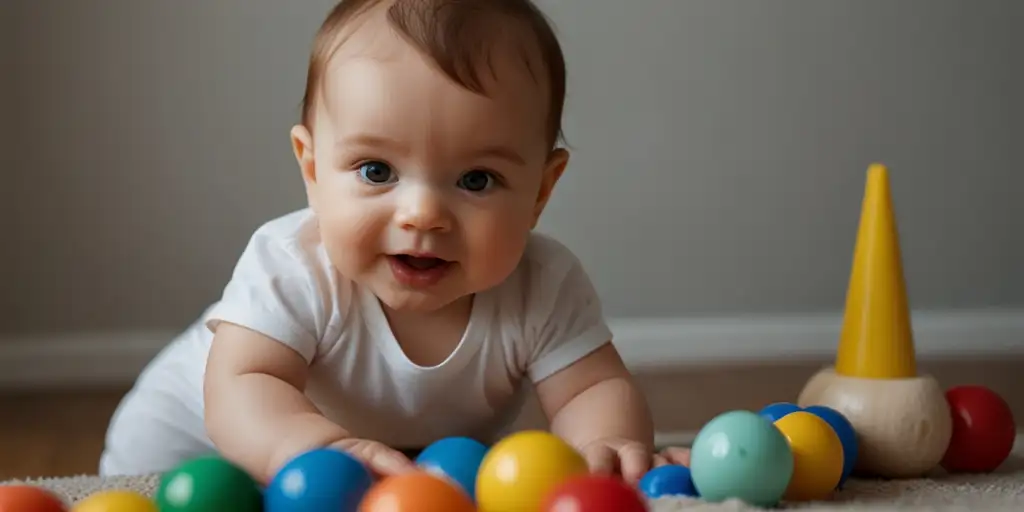Exploring the world is enjoyable for infants, and sensorial activities allow them to learn about new things.
These activities stimulate infant thinking, movement, and feelings. Sensory play is essential for their development. It helps them reach major growth milestones.
Engaging in these activities sets the groundwork for future learning. But why is sensory play so important? Let’s dive deeper into this fascinating aspect of early childhood learning.
What Are Sensory Activities for Infants?
Sensory activities for babies: They are lively experiences of the senses that go on with sight, sound, touch, taste, and smell.
A baby develops their nervous system by such activities. They connect them with surroundings. Examples include feelings of various textures or soothing sounds.
It encourages exploration and discovery. It is useful in learning about the environment. All of the activities can uplift the sensory abilities of the babies. Babies will enjoy playing with tastes and smells.
Sensory experiences form part of the richness of learning. Sensory experience makes learning enjoyable for babies.
Why Sensory Stimulation Is Important
The first years of a child’s life are critical for brain development. During this stage, a lot of neural connections form, influenced by what infants sense around them.
Babies participate in sensory activities to learn about various stimuli. These activities boost their thinking and movement skills.
They also aid in developing emotional regulation. In summary, this time is vital for both mental and physical development in infants.
The Benefits of Sensory Activities
Along with amusing babies, sensory play helps them develop; several important ways infants benefit from such activity follow:
- Cognitive Development: Sensory play helps to develop memory recall, concentration, and problem-solving ability.
- Physical Growth: It refines the grasping and object-manipulating fine motor skills and the gross motor skills as they shift to explore.
- Emotional Development: Sensory activities help infants develop self-regulation, as they learn to calm down and engage with soothing stimuli.
These benefits create a strong foundation for learning and development that will continue throughout childhood.
Types of Sensory Activities for Infants
There are endless sensory activities you can introduce to your infant, each focusing on stimulating a different sense. Below are some popular categories of sensory play:
- Tactile Activities: Engage a baby’s sense of touch with various textures like soft fabrics, squishy toys, or smooth surfaces.
– Auditory Activities: Infants love sounds! Introduce them to music, rattles, or gentle nature sounds.
- Visual Activities: Bright colors, patterns, and shapes catch an infant’s attention and help develop their vision.
- Olfactory Activities: Safe scents such as lavender or vanilla can provide calming sensory input.
- Taste-Based Activities: As infants begin exploring solid foods, introducing different tastes can be a fun sensory experience.
Tactile Sensory Play Ideas
Infants are naturally curious about textures. Simple tactile activities can be done with common household items.
For instance, allowing your baby to touch soft blankets, squishy toys, or textured play mats can help them become familiar with different sensations. You can even create a “feely” box filled with various fabrics like cotton, velvet, or leather.
Auditory Sensory Play Ideas
Sound is one of the first senses to develop in infants. Auditory play can include singing lullabies, playing soft music, or giving your baby a toy that makes noise, such as a rattle or drum. The key is to introduce different sound frequencies and rhythms to foster their auditory development.
Visual Sensory Play Ideas
Your baby’s vision is constantly developing in the early months, so offering visual stimulation is essential.
For example, for simple visual play, there are light-up toys, brightly colored toys, or black-and-white pictures.
It is important to improve their ability to track and focus. You can hang a colorful mobile over your baby’s crib; otherwise, you can place toys with high-contrast patterns in front of him.
Olfactory Sensory Play Ideas
While a baby’s sense of smell is not as highly discussed, it plays an important role in their sensory experience.
To safely engage your baby’s sense of smell, introduce them to calming and familiar scents. Scents like lavender can be soothing, while vanilla may evoke feelings of warmth.
Always ensure that any fragrances used are safe for infants and do not overpower their delicate systems.
Taste-Based Sensory Play Ideas
When your baby is ready to start trying solid foods, mealtime becomes a fantastic opportunity for sensory play. Introducing new flavors, from pureed fruits to mild vegetables, engages their sense of taste. Allowing your baby to play with food can be messy, but it’s an essential part of learning.
DIY Sensory Activities for Infants
You don’t need fancy toys to engage your baby in sensory play! Many household items can be repurposed for stimulating activities.
For example, fill a small, sealable plastic bag with colorful hair gel and small toys to create a fun sensory squish bag.
Or, use a cardboard box to build a sensory fort, with different textures and toys hanging from the inside for your baby to explore.
Safe Sensory Play
Safety is always the top priority when it comes to sensory play. Avoid small objects that could pose a choking hazard, and always supervise your infant during activities. Ensure any toys or materials you introduce are non-toxic and appropriate for your baby’s age.
Outdoor Sensory Activities for Infants
Taking your sensory play outdoors opens a whole new world of exploration to your infant. Everywhere you look, there is endless stimulation-presenting opportunities like the feel of grass beneath their toes or the chirping of birds.
Letting your baby feel a cool breeze, touch the rough bark of a tree, or listen to rustling leaves will give you some simple but very influential sensory experiences that support their attachment to the environment.
Mess-Free Sensory Activities
If you’re terrified of all the mess sensory play sometimes causes, don’t worry; there are plenty of mess-free options too.
For example, you can make a sealed sensory bag or bottle filled with colorful beads or glitter. In this way, your baby will be able to feel it without making a mess. Such types are very useful in developing fine motor skills and without the accompaniment of clean-up.
Sensory Activities for Infants with Special Needs
Tailored sensory play can be very helpful for children with developmental delays and with sensory processing disorders.
For this population of infants, it is crucial to work closely with a pediatric therapist to find those types of sensory input that best fit their needs. Activities must be gentle and established at the baby’s pace to avoid overstimulation.
Sensory Play for Newborns
Newborns are ready to engage in sensory play right from birth! Infants are beginning to recognize soft sounds, gentle touches, and bright colors.
Activities such as lightly rubbing their skin with various materials can enhance their sensory experience. Showing them images with strong contrasts can capture their attention. These experiences help in developing their senses. Engaging in these activities supports their overall growth.
FAQs
What Are the Best Sensory Toys for Infants?
Twin Sensory can help babies further develop essential skills such as fine and gross motor, cognitive, and problem-solving skills, as it also supports babies senses of touch, smell, sight, taste, and sound.
- Soft textured toys: Sleepers with different textures like fleece, velvet, and terry cloth provide engagement for the sense of touch, anchoring hand activities such as hand sewing.
- Rattles and musical toys: These improve vocabulary from early forms of expression through sound.
- Teething toys: Soft rubber toys that are safe for exploratory mouthing are referred to as teething toys.
- High-contrast books or cards: Bold patterned gear and books in striking navy blue and white or black and white help stimulate vision.
- Tummy time mats: Mirrors, crinkly sections, and textured areas found on tummy time mats encourage further baby exploration during tummy time.
How Can I Introduce Sensory Play Safely?
When introducing sensory play for your baby, the following guidelines will aid you in supporting the child’s development optimally:
- Choose age-appropriate toys: Infant toys must be harmless and nonpoisonous. Moreover, the toys should not have small parts that could be removed and lead to choking.
- Supervise at all times: Sensory play with infants should never be done without accompanying them as they have a tendency to put things in their mouths.
- Use non-toxic materials: Sensory 소재 include water, non-allergic playdough, rice, and most household petty items, as these are non-allergenic.
- Be mindful of overstimulation: Calmly observe your child to see if they begin to look away and seem fussy or lazy; this may be an indication of overstimulation.
When Should I Start Sensory Play With My Infant?
The first stages of sensory exploration can begin right after birth.
- 0-3 months: Activities relating to sensation are rudimentary and focus on visual and auditory elements. Incorporate music, gentle touches, and black and white patterned cloths, and give baby massages.
- 3-6 months: At this stage, babies start engaging more. Introduce toys with various textures, mirrors, and rattles.
- 6-12 months: Babies are more eager to engage in physical exploration at this age. They are ready to be safely guided through the use of sensory bins filled with materials such as water or sand. They begin to be taught how to engage with more complex textures and sounds as well as messy play.
What Are Some Mess-Free Sensory Activities?
Clean sensory activities are ideal for when you wish to stimulate your baby’s senses with no clean-up afterward.
- Sensory bags: Use a clear Ziploc bag and fill it with gel or water beads. Seal it, and let your baby engage on his own without making any mess.
- Water play in a sealed container: Use a container filled with water together with floating toys or glitter for water play that can’t spill.
- Soft fabric swatches: Let your baby feel different soft, textured fabrics like velvet, silk, or cotton using soft fabric swatches.
- Light-up toys: Gentle toys with lights can stimulate sight without making a mess, and these are called light-up toys.
Can Sensory Play Help My Baby Sleep Better?
Without a doubt, sensory activities enhance the sleep patterns of infants. It is reasonable to assume that expending energy through play aids relaxation later on. Some of those are described below:
- Promotes relaxation: Soothing forms of sensory play, like the aid of stroking or playing lullabies, can calm an infant before they sleep.
- Creates a routine: Engaging in sensory activities repetitively before sleep can signal to your baby that it is time to wind down.
- Develops self-soothing skills: Babies who encounter multiple textures and sounds are more familiar with these sensations and thus more comfortable, aiding in self-soothing. This makes them more likely to sleep throughout the night.
What Are Signs That My Baby Is Overstimulated During Sensory Play?
Overstimulation happens when a child is subjected to an excessive amount of sensory input in a single moment. Some possible symptoms that could indicate your child is experiencing overstimulation during the sensory game include:
- Fussiness or crying: This is an example where the child is experiencing stress and enhancing frustration. Fussing or crying unexpectedly is often indicative that a child might be experiencing overstimulation.
- Turning away: This behavior is often regarded as a form of non-verbal communication in young children and infants. The same nonverbal cue is used when children turn away from activities or toys, which signals they have had enough.
- Rubbing eyes or yawning: These are indicators of drowsiness that occur as a result of overstimulation.
- Flailing arms or legs: Children may move their arms and legs in a violent manner or become more agitated and physically hyperactive when they are overstimulated.
- Difficulty calming down: When children experience difficulty in settling down after engaging in sensory play, this could be an indication of overstimulation.
Conclusion
Sensory activities are great for helping babies develop. They promote motor skills and help in emotional control. Sensory games are necessary for future learning. It is beneficial to add various sensory experiences in daily life. It supports overall development and welfare.
Being engaged in these activities can increase brain development. Children learn through touch, vision, sound, and smell. Regular sensory games can improve the skills to solve the problem. It encourages curiosity and exploration in infants. Providing these experiences helps infants to reach their full potential.
Hi, I’m Sitara. Writing is my way of connecting with the world and expressing the thoughts that swirl in my heart and mind. At 23, I find myself constantly inspired by the beauty of spirituality, the complexities of love, and the lessons life teaches us every day. My words are a reflection of my journey—raw, honest, and deeply personal. I hope my stories and reflections resonate with you, offering comfort, inspiration, or simply a moment of quiet introspection.
Thank you for being here and sharing this space with me. Let’s explore the depths of life together.




